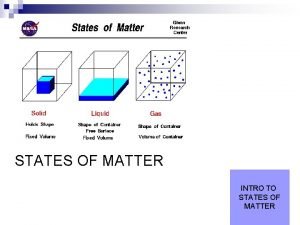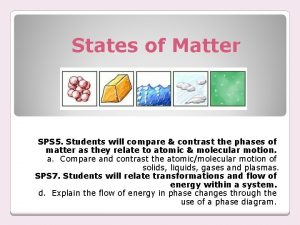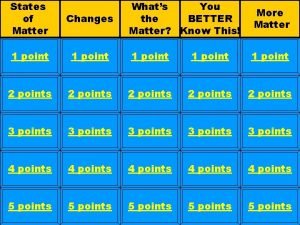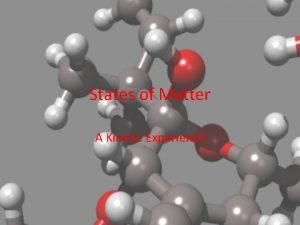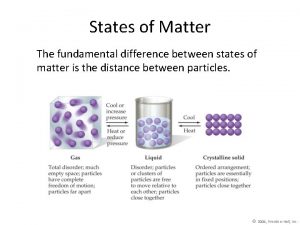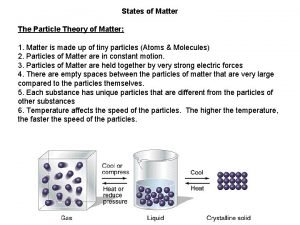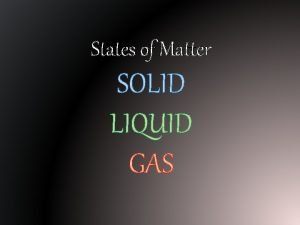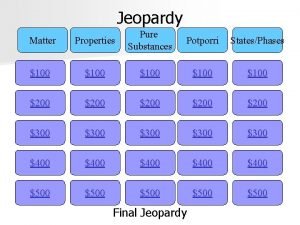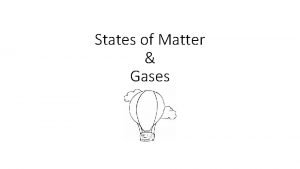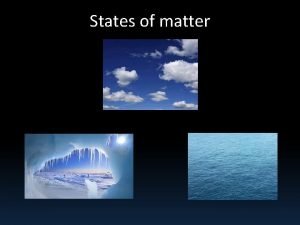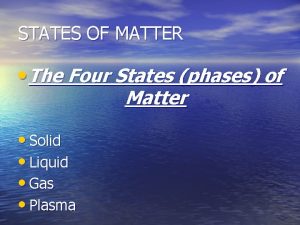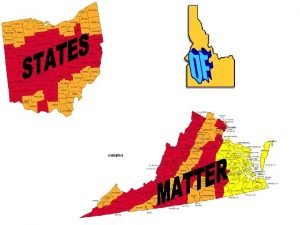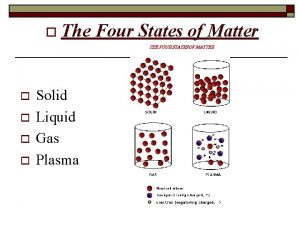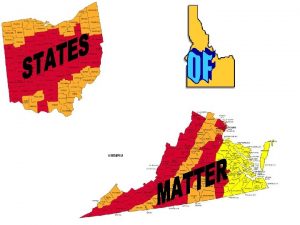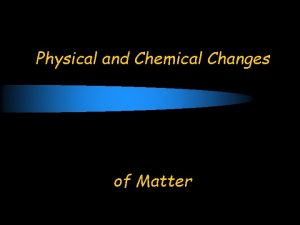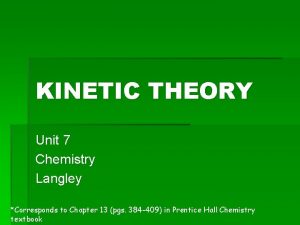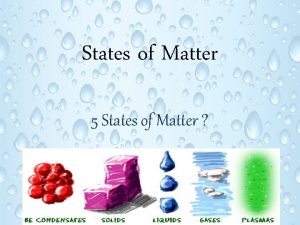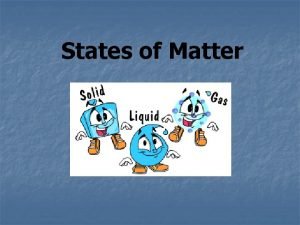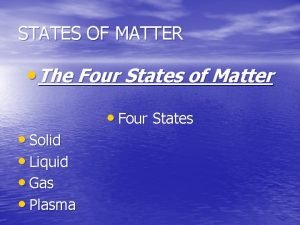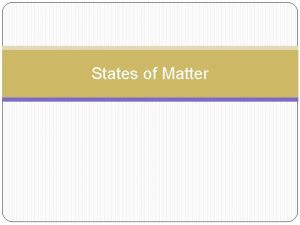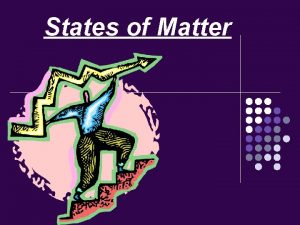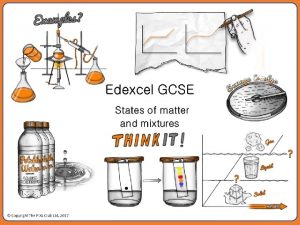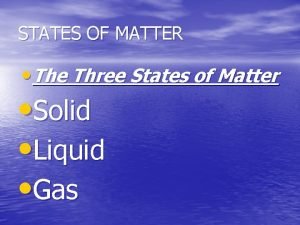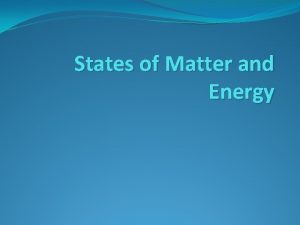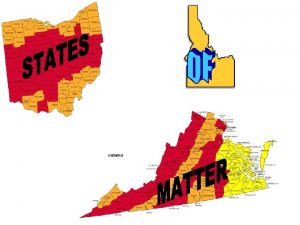STATES OF MATTER INTRO TO STATES OF MATTER









































- Slides: 41

STATES OF MATTER INTRO TO STATES OF MATTER

SOLIDS LIQUIDS AND GASES Objectives: ¨ To n classify materials into their state of matter using their shape and volume. ¨ To explain the behavior of gases, liquids, and solids using the tools of kinetic theory and forces of attraction. Vocabulary Solid ¨ Liquid ¨ Gas ¨ Kinetic energy ¨

Identifying the States of Matter In a few minutes you will be able to fill this out. Think about the relationship between the states of matter throughout this lesson.

SOLIDS LIQUIDS AND GASES n Describing the States of Matter ¨ You learned about classifying matter based upon it’s uniformity of composition, by its physical properties, and by its chemical properties. ¨ Materials can also be classified by their state of matter. ¨ These physical properties of a substance are: solids, liquids, and gases based on whether their shapes and volumes are defined or variable.

SOLIDS LIQUIDS AND GASES n n n Remember, shape is determined by being able to measure height, length and width. Volume is determined by how much space the matter takes up, determined by multiplying these together or using a graduated cylinder. The description of shape and volume can be discovered and measured, but what is to be understood is that these are entirely due to the relationship of the molecules and atoms of the matter’s make-up.

The Basic Atom; All matter is made of Atoms

The Distance Matters… n Matter can have its atoms close together….

The Distance Matters… n Or Far Apart… n And it’s still the same matter, just in a different state.

n We’re going to focus on the shape and volume first.

n Solid: is the state of matter that has a definite shape AND volume. ¨ Usually the shape of a solid or its volume is not influenced by its container. ¨ Shape and volume of a solid can only be changed by doing something to it physically like cutting it in half. ¨ Atoms of solids are tightly compacted.

Solid

SOLIDS LIQUIDS AND GASES n Liquid: the state of matter in which a material has a definite volume but NOT a definite shape. ¨ Remember the video: If we have 250 ml of water we can place it in a variety of differently shaped containers. ¨ The volume won’t change but the shape changes. ¨ Atoms of liquids are close together but have more freedom to move and are arranged in random unlike solids where there is a definite arrangement of atoms.

Liquid n Regardless of the shape a liter is always a liter.

SOLIDS LIQUIDS AND GASES n Gas: Is the state of matter in which a material has NO definite shape OR volume. ¨ Gas atoms and molecules are so spread apart that they take the shape and volume of their container. ¨ Gas atoms are highly mobile, spread out, and not arranged in any definite pattern. ¨ Consider helium inside a balloon. ¨ The atoms’ arrangement is only restricted by the balloon’s dimensions (its volume).

Gas Balloons can have the same number of atoms in different volumes and shapes. n When their atoms are released into the air they can go everywhere… n

Happy Birthday Happy y p Hap Birthday h t r i B Happy Birthday Happy Birthday. Hap py Birthd Happy ay Birthday Happy Birthday n Birthday Happy Birthday n Happy Birthday Happ py y Birthday y p Birth Hap H B a i d p r thday ay py n Birthday B irthday Happy Birthday Happy y Happy Birthday ay Birthday Happy Hap hd Birt py Birthday Hap hda py y Birth Happy day Happy Birthday Think about a helium tank… How big of a balloon can 1 helium tank fill? Or how many balloons can one tank fill? The question I have for you is how can so much gas be inside such a small container?

Concept Check: Definite or Indefinite? Shape Volume Solid Definite Liquid Indefinite Definite Gas Indefinite

SOLIDS LIQUIDS AND GASES n FYI: There are 2 other states of matter, the 4 th & 5 th states… All matter we are exposed to on earth is either solid, liquid or gas. ¨ Most matter in the universe (99% of it) is actually in a state of very high temperature such as is found on stars, like our sun. ¨ This 4 th state of matter is called Plasma. ¨ ¨ Plasma = an electrically conducting medium in which there are roughly equal numbers of positively and negatively charged particles, produced when the atoms in a gas become ionized. A 5 th state of matter exists at very cold temperatures nearly close to -273 degrees C. ¨ This 5 th state is called Bose-Einstein Condensate or BEC. ¨ This state of matter behaves like a single particle, able to conduct electricity with nearly no electrical resistance and, in liquid form, electricity flows indefinitely. ¨

Identifying the States of Matter Look at your notes outline. The four terms correspond to one of the four letters. Match the word with the letter and write this on your notes outline. 30 seconds. a. b. c. d. definite shape definite volume variable shape variable volume

Reinforce the basics…. 2 other states of matter

Understanding States of Matter n To begin to understand why certain elements at room temperature are in their respective states… ¨ Why is copper a solid, ¨ Why is mercury a liquid, ¨ & why is helium a gas … n You need to know about kinetic energy.

SOLIDS LIQUIDS AND GASES n Kinetic Energy: the energy an object has due to MOTION. Kinetic energy is then a. k. a. the energy of motion. ¨ A boulder balanced on a cliff has no motion therefore no kinetic energy. ¨ A ball flying through the air has kinetic energy. ¨ A car driving down the highway has kinetic energy. ¨ A car driving faster has more. ¨ How much kinetic energy depends on how fast the object is moving. ¨ Basically, the faster an object moves, the more kinetic energy the object has. ¨ Leads us to the Kinetic Theory of Matter ¨

Which has more kinetic energy? Baseball # 1 Or Baseball #2

Kinetic Theory of Matter n …States ALL particles of matter are in constant motion, regardless of state. ¨ In any state of matter all the particles are in motion. ¨ In theory, even particles that make up a solid are in motion. n They are vibrating. Particles that make up a liquid are also in motion, bouncing around hitting each other. ¨ But what is the difference between a theory and a law? ¨ Theory: A well-tested explanation for a SET of observations or experimental results ¨ Law: A statement that summarizes patterns found in nature ¨ Why would this be considered a theory and not a law? ¨

…ALL particles of matter are in constant motion. n n n If a pitcher throws a baseball, the ball is in motion, yes. But so are the particles inside the ball as well as particles in the air the ball is moving through. Even if the baseball isn’t moving, the kinetic theory says that all matter, regardless of the object’s overall motion, is in some kind of motion.

The atoms inside a baseball aren’t really moving around that much though. They are actually just vibrating in one spot. Kinetic theory says that they are moving though. If we were to isolate atoms of the baseball we could see them vibrating. . . even when the baseball is standing still.

SOLIDS LIQUIDS AND GASES n Explaining the behavior of Matter ¨ Particles everywhere always moving. ¨ The difference between different states of matter is how fast the particles are moving and how far apart they are. ¨ Solids have their atoms packed tightly together and the atoms are moving slowly. ¨ Gases have atoms that are spread very far apart and the atoms are moving fast. ¨ Liquids fall in the middle. The atoms are moving faster than in solids but slower than the atoms in gases.

Forces at Work n n n n There are fundamental laws that you should consider. Like charges repel. ? Opposite charges attract. ? If you notice, atoms have negatives on the outside and positives on the inside. This provides two scenarios that can be influenced by Kinetic Energy. If atoms are moving slow then the attractive force of nucleus to electron cloud between different atoms overcomes the repulsive force. If the atoms are moving quickly though, the attractive force never has a chance to establish a bond.

SOLIDS LIQUIDS AND GASES n Explaining the behavior of GASES ¨ Particles that compose gases are always in motion bouncing off of one another. ¨ As one particle hits the other it effects its kinetic energy by causing it to speed up or slow down due to the collision. n Think of billiard balls on a pool table except the balls never stop rolling. ¨ There are forces of attraction among particles in all matter. n But in gases the particles are moving so fast that the force of attraction is weak and almost non-existent.

SOLIDS LIQUIDS AND GASES n Kinetic Theory of Gases ¨ Constant motion of particles in a gas allows it to fill a container of any shape or size. ¨ This is because the particles are always rebounding off one another. n If there were a small hole in the container the gas escapes because some particles are knocked out through the hole. ¨ Make a prediction: ¨ Spray some perfume in the back corner of the room. ¨ What should happen? ¨ The kinetic theory says that soon we’ll all be able to smell the perfume.

Kinetic Theory of Gases: Summary of the 3 main points n n Because gas particles are moving so fast… Particles in a gas are in constant random motion. The motion of one particle is unaffected by the motion of other particles unless the particles collide. Forces of attraction among particles in a gas can be ignored under ordinary condition.

Particles in a gas are in constant random motion. n. The motion of one particle is unaffected by the motion of other particles unless the particles collide.

The motion of one particle is unaffected by the motion of other particles unless the particles collide. C li l o n o i s

Forces of attraction among particles in a gas can be ignored + under ordinary condition. Water molecules are attracted to each + other like magnets. When slow enough -2 (cool) the water molecules bond together to form liquids and solids. -2 + + But when they are moving in the air with enough speed and distance they are unaffected by each other.

SOLIDS LIQUIDS AND GASES Gases in motion… Regardless if you can see them or not, the particles are their moving incredible quick.

SOLIDS LIQUIDS AND GASES n Explaining the Behavior of Liquids ¨ Particles in liquids have kinetic energy too. ¨ They just have less kinetic energy than those of gases. ¨ Liquid particles are more closely packed than those of a gas. ¨ In a liquid some particles are in constant motion while others are attracting one another. ¨ A liquid takes the shape of its container because particles in a liquid can flow to a new location. ¨ The volume of a liquid is constant because forces of attraction keep the particles close together.

SOLIDS LIQUIDS AND GASES n Explaining the Behavior of Solids ¨ Solids have a definite volume and shape because particles in a solid vibrate around fixed locations. n Vibration is a repetitive back and forth motion ¨ They seem solid because the atoms in solids have strong attractions to one another, which restrict their motion n These are called bonds, but we will cover this soon enough ¨ Atoms vibrate but do not exchange places with other atoms due to forces of attraction in close proximity.

Why are solids in motion? +++ - - - Because even stationary matter has moving parts in its atoms.

Add energy (Heat to melting) H 2 O as a Liquid = Water: Medium Kinetic Energy Add More energy (Heat to boiling) H 2 O as a Gas = Water Vapor: A lot of Kinetic Energy Increasing temperature H 2 O as a Solid = Ice: Low Kinetic Energy

Using the Kinetic Theory… n Explain this phenomenon. If there is a natural gas leak in the basement of a 10 story building occupants will soon notice by the foul odor. However, if that same building had a water leak someone would have to go there to detect it.

Summary n n The Kinetic Theory states that all matter is in constant motion, regardless is it’s moving. States of matter are physical properties that explain the matter’s level of kinetic energy. The states (solid, liquid, or gas) can be defined by whether the matter has defined volume & shape or not. The behaviors of solids, liquids and gases are related to how much kinetic energy the matter has and how closely the atoms are packed together.
 All matter is in constant motion
All matter is in constant motion Gray matter in the brain
Gray matter in the brain 5 states of matter
5 states of matter States of matter basics
States of matter basics Ecological succession
Ecological succession Solid matters
Solid matters Interconversion of states of matter
Interconversion of states of matter Whats the four states of matter
Whats the four states of matter 5 states of matter
5 states of matter Chapter 2 matter section 1 classifying matter answer key
Chapter 2 matter section 1 classifying matter answer key The fundamental difference between states of matter is the
The fundamental difference between states of matter is the Phases of matter foldable
Phases of matter foldable Frontal and parietal lobes
Frontal and parietal lobes Southern states vs northern states
Southern states vs northern states What is the particle theory of matter
What is the particle theory of matter Which state of matter has the most thermal energy
Which state of matter has the most thermal energy Composition of matter section 1
Composition of matter section 1 States of matter foldable
States of matter foldable Jeopardy states of matter
Jeopardy states of matter Flow chart for classifying matter
Flow chart for classifying matter States of matter
States of matter States of matter venn diagram
States of matter venn diagram Gyrus and sulcus function
Gyrus and sulcus function Stayes of matter
Stayes of matter Four states of matter
Four states of matter States of matter
States of matter Vocab
Vocab Section 1 composition of matter
Section 1 composition of matter 4 phases of matter
4 phases of matter Changing states of matter
Changing states of matter States of matter mind map
States of matter mind map Heat vs thermal energy vs temperature
Heat vs thermal energy vs temperature Checks and balances dbq
Checks and balances dbq Five states of matter
Five states of matter States of matter jeopardy
States of matter jeopardy The kinetic theory of matter states that
The kinetic theory of matter states that Section 1 composition of matter
Section 1 composition of matter Plasma particle arrangement
Plasma particle arrangement Four states of matter
Four states of matter Chapter 10 review states of matter section 4
Chapter 10 review states of matter section 4 States of matter
States of matter 5 states of matter
5 states of matter
